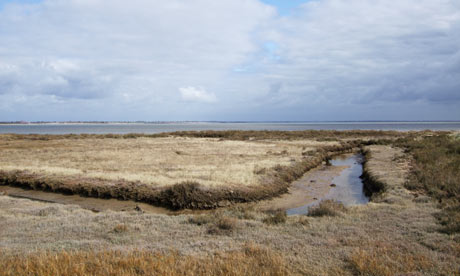
"Civilization didn't dare go any further," says artist Tracey Saunders, as we arrive at, well, the end of the road. And she's right. A five minute stroll eastwards out of Essex yachting haven Burnham-on-Crouch, and that's it. No roads. No houses. Just miles of salt marsh and milky sky. It's this vista that inspired Wells's Martian landing in War of the Worlds; and Hitchcock, on a visit here after the war, to film The Birds. "The only way out", Tracey adds, "is via the river or on foot. I like that."
In a much misunderstood county, the Dengie Peninsula is a hidden gem; an Area of Outstanding Natural Beauty pinned by the North Sea to the east, the River Crouch to the south and the River Blackwater to the north. Its isolation has amounted to a miniscule population (the peninsula's largest town, Burnham, has just 7,500 inhabitants) despite being just an hour from London. Even the name - which sounds rather shabby - isn't very accurate: Dengie itself is a local hamlet (population: 100) whose etymology eludes everyone we meet.
While it may be a little off the general radar, the peninsula brims with history - nowhere more so than on Burnham's bygone high street and quayside, with its octagonal Clock Tower, white clapboard cottages, Georgian red brick houses, and the famous Deco Royal Corinthian Yachting Club.
Tracey takes us on a wander along the salt marshes and through the jumble of boats in the shipyard by the marina, dug out 20 years ago. We gasp at palatial houseboats sucked into green mud, not just home to the usual beardy creatives, but "commuters emerging on to their pontoons in perfect suits", she says.
With all the nautical talk I feel an overwhelming urge to get on the water myself, and so head to one man who reputedly holds the key to the creeks: "We could be in Whitstable in half an hour," says Gary Dunn, revving the tub-like vessel's engine up, a grin engulfing his face.
Against a bitter wind, the shaggy grey clouds uncertain above us, we speed past shipwrecks clasping hoary shores while Gary, a natural storyteller, unfurls anecdotes peppered with alien names: Stairgate Creek, Paglesham, Foulness Island. Brent geese, shelduck and oyster catchers fill the skies before we reach a colony of common seals: "The red in the young seals is unique to the creeks," he points out, their heads bobbing about like humans in the water. "This is deepest darkest Essex, so close but so far away," Gary whispers as we hover round eerie Potton Island. "There used to be plenty of piracy going on here," he adds with a chuckle.
And, like a good pirate, the peninsula unveils its treasure quietly, nowhere more so than our base, Mangapp Manor, which dates back to the 16th century. It's the polar opposite of the bland boutique hotel: dark-panelled interiors, creaking wooden floors, locked medieval chests, looming oil paintings, beamed bedrooms. But most impressive is its stunning 12 acres of grounds, including a carp lake with gazebo, a rather proprietorial goose and some lumbering highland cattle. The best bit? Yours for £65 a night.
Dominating the local eating scene is the Oyster Smack Inn and adjoining Galley Restaurant, which, despite their unprepossessing main road location, both offer up sensational locally-sourced fare from ex-Ramsay chef Trevor Howell. In the Smack's simple dining room, we feast on Maldon oysters, seared scallops, buttery Hanningfield trout, and succulent sea bream.
On our final morning Tracey takes us on a six-mile circular route around the wilderness of the northern peninsula. A straight grassy path, trodden by thousands of pilgrims since Roman times, leads us through the howling wind towards the atmospheric church of St Peter-on-the-Wall, built in 654 AD.
After sheltering inside its stone interior, we emerge blinking into the mackerel skies over the cockle spit. We follow the sea wall, built to protect 750 acres of marsh under sea level, along the shell beach dotted with pill boxes, and gaze beyond at fringes of netting posts on the rhythmic ribs of sand left by the tide. Across the water, the opaline light illuminates Mersea Island's ice cream-coloured beach huts, whilst just around the bay, the decommissioned husk of Bradwell Power station looms beyond the cornfields under a solid grey shelf of sky.
"The water seeping into mud, the wrecks, there's more to it than meets the eye," said Tracey, back in Burnham. "It's not tidy, this peninsula, it's not conventionally pretty, but there's something about it that gets right inside you."
Further information
Mangapp Manor, double rooms with breakfast from £65, call Kate Wilsdon on +44 (0)7769 676735, mangappmanor.co.uk
Lady Essex organizes boat trips for £15 a person. Gary Dunn: +44 (0)1702 258 666, ladyessex.com
Tracey Saunders, founder of Burnham Art Trail
The Oyster Smack/The Galley Restaurant, +44 (0)1621 782141, theoystersmackinn.co.uk
For more information see visitessex.com

